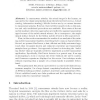Free Online Productivity Tools
i2Speak
i2Symbol
i2OCR
iTex2Img
iWeb2Print
iWeb2Shot
i2Type
iPdf2Split
iPdf2Merge
i2Bopomofo
i2Arabic
i2Style
i2Image
i2PDF
iLatex2Rtf
Sci2ools
RAID
2015
Springer
2015
Springer
HelDroid: Dissecting and Detecting Mobile Ransomware
In ransomware attacks, the actual target is the human, as opposed to the classic attacks that abuse the infected devices (e.g., botnet renting, information stealing). Mobile devices are by no means immune to ransomware attacks. However, there is little research work on this matter and only traditional protections are available. Even state-of-the-art mobile malware detection approaches are ineffective against ransomware apps because of the subtle attack scheme. As a consequence, the ample attack surface formed by the billion mobile devices is left unprotected. First, in this work we summarize the results of our analysis of the existing mobile ransomware families, describing their common characteristics. Second, we present HelDroid, a fast, efficient and fully automated approach that recognizes known and unknown scareware and ransomware samples from goodware. Our approach is based on detecting the “building blocks” that are typically needed to implement a mobile ransomware applicati...
| Added | 17 Apr 2016 |
| Updated | 17 Apr 2016 |
| Type | Journal |
| Year | 2015 |
| Where | RAID |
| Authors | Nicoló Andronio, Stefano Zanero, Federico Maggi |
Comments (0)

